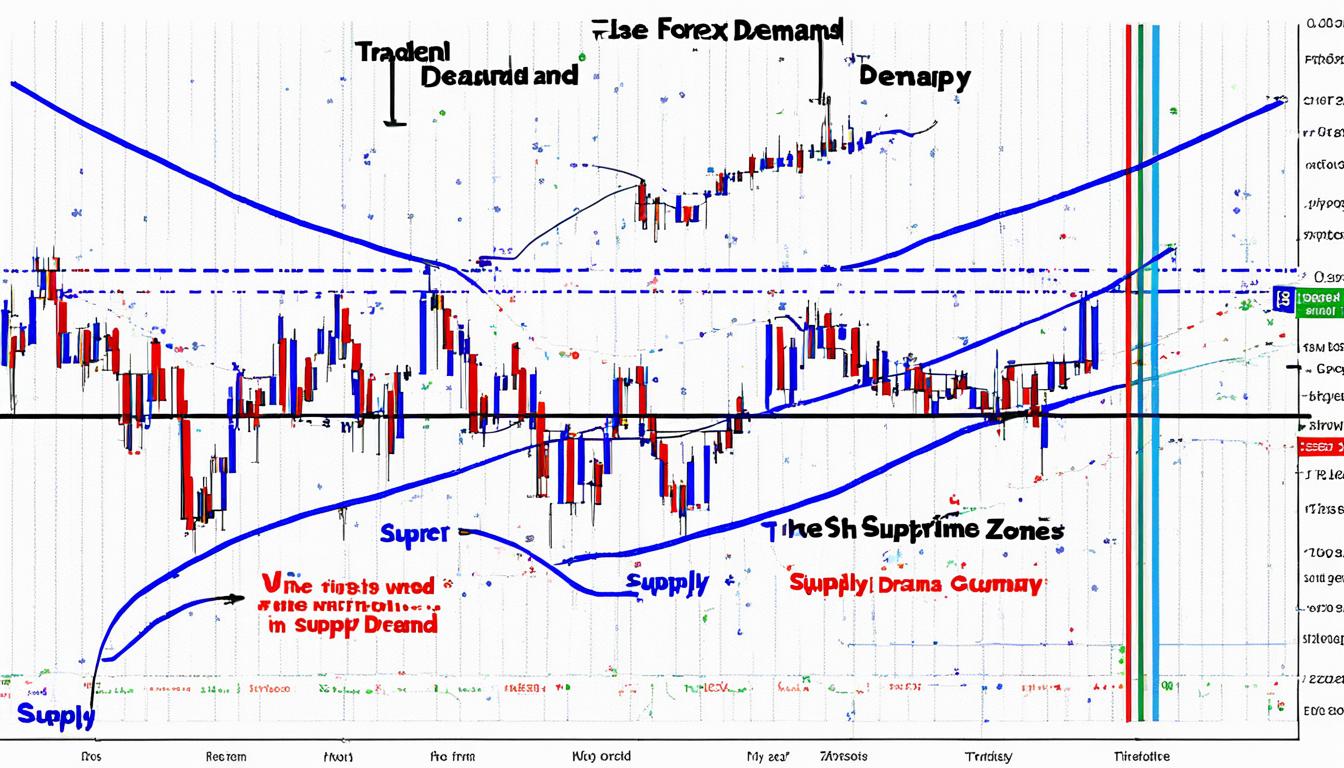Supply and demand zone trading is key for forex traders wanting to improve their market analysis. It helps them find the best times to buy or sell. Knowing how supply and demand work in the forex market is vital for traders aiming to make the most of market trends.
These zones make it easier for traders to understand market ups and downs. They show where prices might change direction. Whether you’re new or experienced, learning about supply and demand zones can boost your trading skills. It’s especially useful in the fast-paced world of forex trading. Using these tools helps traders make smart choices and follow effective trading tips.
Key Takeaways
- Supply and demand zone trading is essential for accurate market analysis.
- Understanding these zones aids in identifying potential entry and exit points.
- They offer insights into market dynamics and price action.
- Informed trading decisions can result from mastering these concepts.
- Effectively using zones enhances strategies in forex trading.
Understanding Supply and Demand Zones
Supply and demand zones are key in Forex trading. They help traders predict price changes and make smart choices. Learning about these areas makes understanding the market and technical analysis easier.
Defining Supply and Demand Zones
Supply zones are where many sellers are, which might make prices go down. Demand zones are where buyers are strong, likely pushing prices up. Knowing where these zones are is vital for using market tools well.
The Importance in Forex Trading
In Forex, knowing supply and demand zones can change a trader’s strategy. These zones are strong support and resistance levels. They help predict market moves, making trading decisions better.
Technical Analysis for Beginners
For new traders, learning technical analysis is a must. Using supply and demand zones is a good start. It helps spot price patterns, plan strategies, and build trading confidence.
How to Identify Supply and Demand Zones
Identifying supply and demand zones is key for trading success. These zones show where buyers and sellers clash, leading to big price changes. Using trading psychology and a price action strategy helps spot these zones better.
Chart Patterns and Indicators
Chart patterns and technical indicators are vital for finding supply and demand zones. Patterns like double tops and head and shoulders show strong supply or demand areas. Indicators like moving averages help confirm these zones too.
Support and Resistance Levels
Support and resistance levels are crucial for spotting supply and demand zones. Support is where demand stops prices from dropping. Resistance is where supply stops prices from going up. Knowing these levels helps traders make better decisions.
Visual Tools for Market Analysis
Visual tools like trend lines and Fibonacci retracements help analyze supply and demand zones. They let traders see market trends and find good entry and exit points. Using these tools with trading psychology and a price action strategy makes trading stronger.
For more on this topic, check out this guide on supply and demand zones.
In summary, finding supply and demand zones needs a mix of chart patterns, indicators, and visual tools. By combining these, traders can better analyze the market and refine their strategies.
Key Strategies for Supply and Demand Zone Trading
To make the most of supply and demand zone trading, a strategic approach is key. This section will cover important methods. We’ll look at finding the best entry and exit points and using advanced strategies like price action trading.
Entry and Exit Points
Finding the right times to enter and exit trades is crucial. Supply and demand zones help traders spot likely areas for starting and ending trades. When prices hit these zones, it often means a change in direction is coming. This gives traders clear signals.
Using support and resistance levels with these zones makes predictions more accurate. This ensures trades are made at the best times.
Price Action Trading Strategy
Adding a price action trading strategy can improve your trading accuracy. This method looks at past price trends to guess future market moves. It helps traders see when supply and demand zones might change.
By using real-time data and patterns, traders can make smarter choices. This is great for beginners who find technical analysis hard. It breaks down complex market trends into simple patterns.
Combining with Other Technical Indicators
Adding supply and demand zone strategies with other technical indicators can give a deeper market view. Tools like Moving Averages, RSI, and MACD can confirm when to enter or exit the market. This approach checks trading signals from price action and support levels.
It makes trading more precise and boosts performance.
Supply and Demand Zone Trading in Forex
Trading in the forex market using supply and demand zones needs a deep understanding of market dynamics and sharp analytical skills. Traders use market analysis tools to spot these zones. This helps them make informed decisions and get the best entry and exit points for trades.
For intraday traders, watching price movements closely is key to finding supply and demand shifts. Knowing these zones helps predict price changes. This can lead to more profitable trades.
Tools like volume indicators, Fibonacci retracements, and moving averages help traders find supply and demand zones more accurately. Volume indicators show how active trading is at certain prices. This helps spot strong supply or demand areas.
Supply and demand zones greatly affect both short-term and long-term forex strategies. Here’s a table that shows how these zones are used in different trading times.
| Trading Strategy | Application of Supply and Demand Zones | Benefit | Market Analysis Tools Used |
|---|---|---|---|
| Intraday Trading | Quick decision making based on real-time demand-supply shifts | Maximized short-term profits | Volume indicators, moving averages |
| Long-Term Trading | Identifying major support and resistance areas | Enhanced long-term profitability | Fibonacci retracements, historical price data |
Using intraday trading tips and understanding forex supply and demand gives traders a big advantage in fast-changing markets. Those who get these concepts and tools can move through the forex market successfully.
Risk Management Strategies
Trading in the forex market comes with risks. It’s key to use strong risk management strategies. This includes setting stop-loss orders, diversifying trades, and managing leverage.
Setting Stop-Loss Orders
Using stop-loss orders is a key risk management tactic. It lets traders set a price where a trade will close automatically. This limits losses in volatile markets.
Diversifying Trade Positions
Diversifying trades is also crucial. By investing in different assets, traders lessen the effect of a single trade’s loss. This strategy helps manage risk and boosts chances of making money by using various market conditions.
Managing Leverage in Forex Trading
Leverage can increase both gains and losses in forex trading. It’s important to use leverage carefully. Traders should pick conservative leverage ratios and use risk management strategies to prevent big losses. Knowing how leverage works and staying disciplined are important for trading success.
Psychological Aspects of Trading
Trading is more than just numbers and strategies. It’s also about understanding how emotions affect our decisions. Feelings like fear and greed can lead to poor choices. Traders need to watch out for these emotions to stay on track.
Using trading psychology techniques can help manage emotions and make better decisions. Setting clear goals that fit your risk level is a good start. This gives you direction and lowers stress.
Managing risk is also key. Tools like stop-loss orders can limit losses and control emotions. Diversifying your trades spreads out the risk, protecting you from big losses.
Sticking to a trading plan is another way to stay disciplined. This means making decisions based on analysis, not feelings. Reviewing and adjusting your plan helps it work better over time.
In the end, mastering trading’s psychological side is crucial. With good trading psychology and risk management, trading can be more rational and successful.
Conclusion
As we wrap up our guide on supply and demand zone trading, let’s highlight the key points. Knowing how supply and demand zones work is crucial for traders. It helps them improve their market analysis and trading plans.
By understanding these concepts, traders can spot the best times to buy or sell. This knowledge greatly impacts their trading results.
We’ve covered many strategies and techniques in this article. We showed how supply and demand zones are key in forex trading. They help traders find important zones on charts and use them with other indicators.
Adding strong risk management strategies is also key. This helps traders deal with the ups and downs of the forex market confidently.
Learning and adapting are vital in the fast-changing world of forex trading. By staying updated and improving their skills, traders can better predict market trends. This way, they can make the most of trading opportunities.
Remember, the key to success is continuous learning and being open to change. Always be ready to learn more and adapt to the market. This approach will be your strongest asset in trading.
FAQ
What is supply and demand zone trading?
Supply and demand zone trading is a strategy for forex traders. It helps spot key areas where the price might change. These areas are where lots of buying or selling happens.
Why are supply and demand zones important in forex trading?
These zones are key because they show where the price might turn around. They help traders make smart choices. This can make trading more profitable.
How do support and resistance levels relate to supply and demand zones?
Support and resistance levels are lines on charts that show where the price often stops or changes direction. They often match supply and demand zones. This helps traders make better trading decisions.
What are some market analysis tools that can help identify supply and demand zones?
Tools like chart patterns, technical indicators, and candlestick patterns are useful. Visual tools also help traders spot these zones.
Can beginners use technical analysis to identify supply and demand zones?
Yes, beginners can learn to spot these zones with technical analysis. It involves reading charts, understanding indicators, and recognizing patterns.
What are some intraday trading tips for using supply and demand zones?
For intraday trading, keep up with market news and use short-term charts. Apply risk management by setting tight stop-loss orders and diversifying trades.
How can price action trading strategies enhance supply and demand zone trading?
Price action trading strategies use market price patterns to improve entries and exits in supply and demand zones. They give a clearer picture of market sentiment and movements.
What are some trading psychology techniques that can improve supply and demand zone trading?
Techniques like emotional control, setting realistic goals, and following a trading plan help avoid impulsive decisions. They keep traders from acting on fear or greed.
How should traders manage risk when trading supply and demand zones?
Manage risk by setting stop-loss orders, diversifying trades, and controlling leverage. This helps limit losses in volatile markets.
What are visual tools for market analysis that can help with identifying supply and demand zones?
Tools like trend lines, Fibonacci retracements, and volume profile analysis help traders see supply and demand zones on charts. They make spotting trading opportunities easier.






